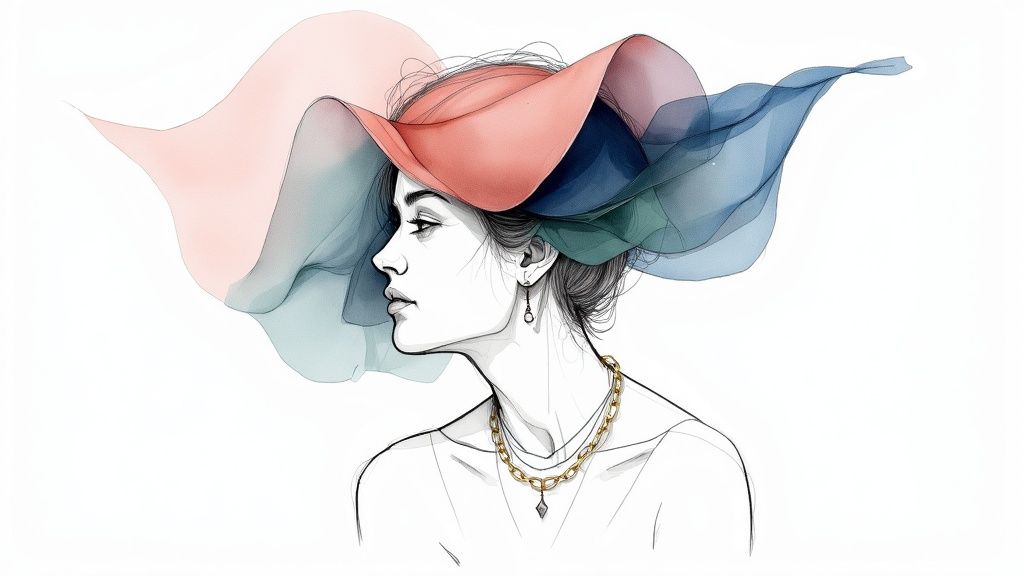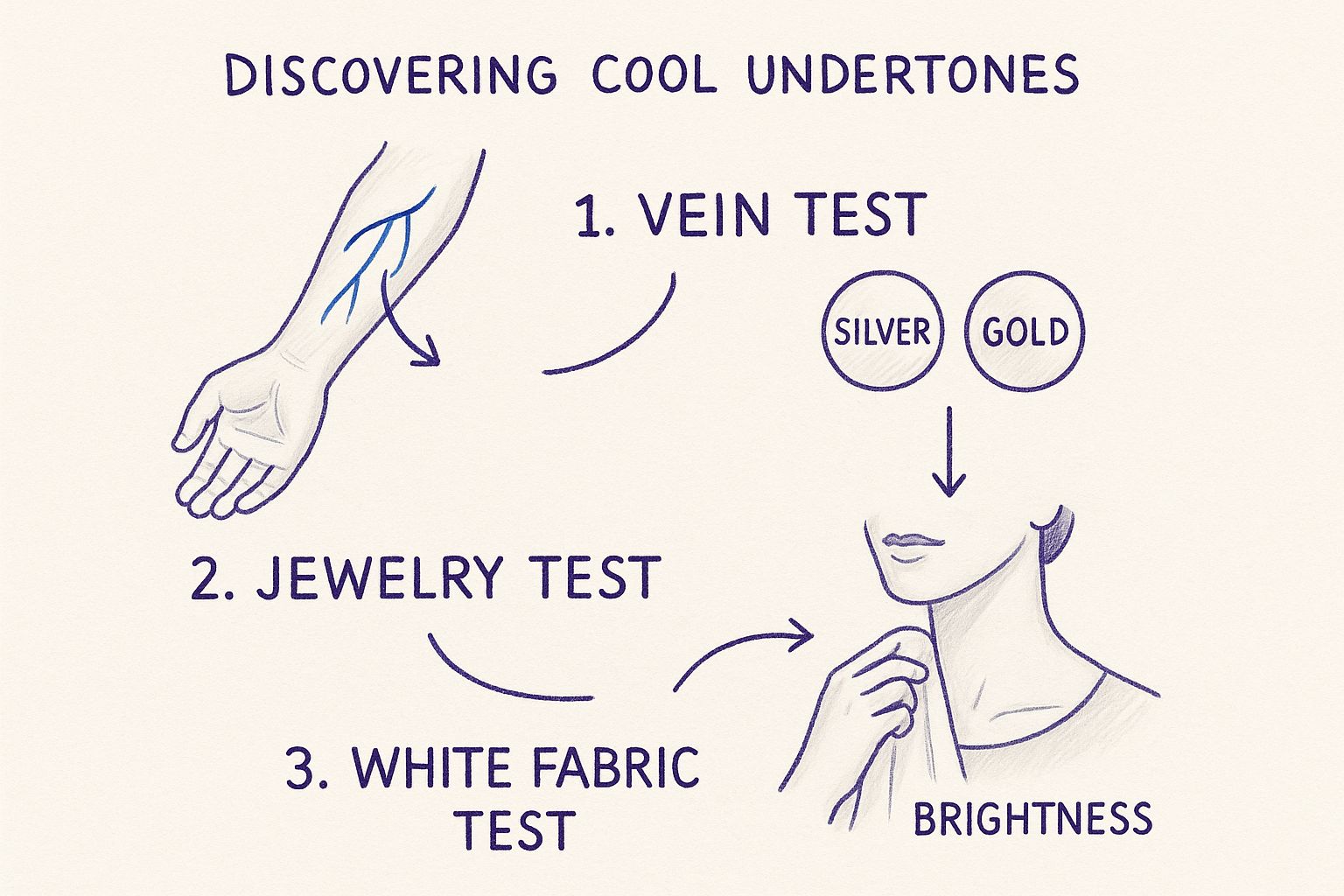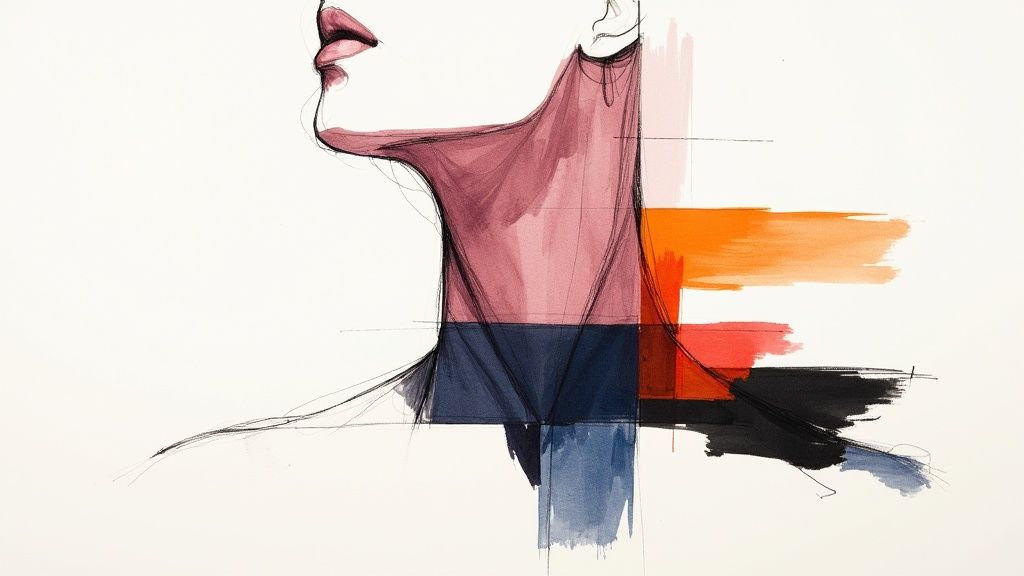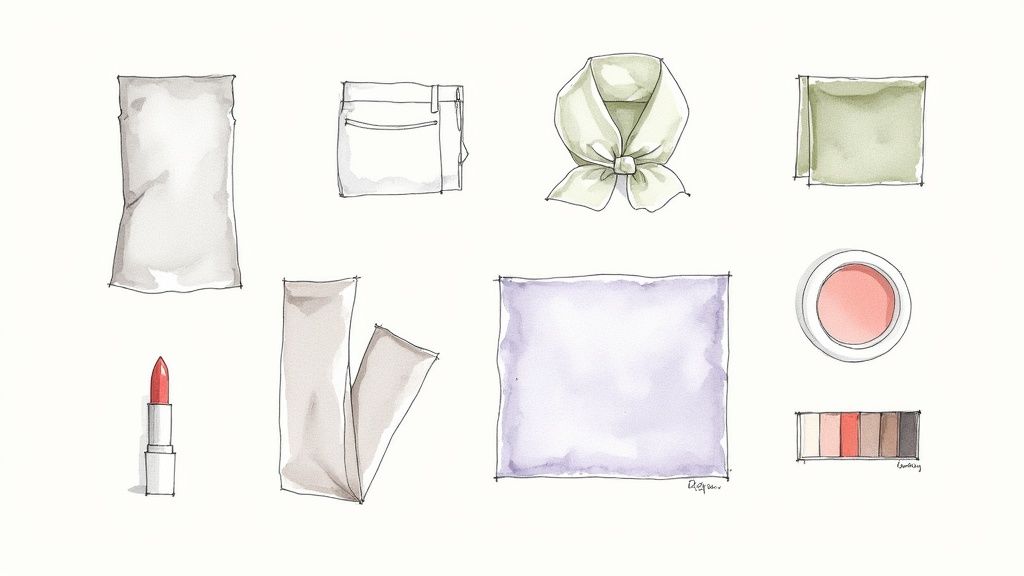
How to Know If You Are a Summer: Find Your Perfect Color Palette
By Emma Johnson - 10/17/2025
Trying to figure out if you're a Summer? It all comes down to two things: cool, blue-based undertones in your skin and a soft, muted contrast between your hair, skin, and eyes. This isn't about the month you were born in, but about the delicate, gentle quality of your natural coloring.
What It Really Means to Be a Summer

Before we get into the nitty-gritty of testing, let's get the vibe right. The Summer palette is all about softness and coolness. Forget the sharp, electric colors of Winter or the warm, earthy tones of Autumn. Instead, picture a hazy, overcast summer day—the colors are beautifully blended, serene, and almost dreamlike.
So, what are the tell-tale signs you might be a Summer?
- Cool Undertones: Your skin has a subtle blue, pink, or reddish base, not a golden or peachy one.
- Soft Contrast: There isn’t a stark difference between your skin, hair, and eye color. It's all very gentle and blended.
- Muted Coloring: Your natural hair is likely on the ashy side (think ash blonde or mousy brown) and lacks natural red or gold highlights.
The Three Summer Sub-Types
Of course, not all Summers are created equal. The season is actually broken down into three distinct sub-types, and finding yours is the key to unlocking the exact shades that make you look incredible.
Key Takeaway: The single most defining trait of a Summer is that combination of cool undertones and low contrast. If your features have a warm, golden quality or a very sharp, dramatic look, you're probably in a different seasonal family.
This handy table breaks down the three Summer variations. See if you can spot yourself in one of these descriptions before we move on to some practical tests.
Summer Seasonal Color Profile at a Glance
A quick comparison of the defining features for the three primary Summer sub-types, helping you pinpoint your specific profile.
| Feature | Light Summer | Cool (True) Summer | Soft Summer |
|---|---|---|---|
| Overall Vibe | Delicate, Ethereal, Fresh | Classic, Refined, Rosy | Mellow, Blended, Gentle |
| Defining Trait | Lightness | Coolness | Mutedness |
| Best Colors | Pastel Pinks, Sky Blues, Lavender | Fuchsia, Royal Blue, True Gray | Dusty Rose, Sage Green, Taupe |
Recognizing your features in one of these columns is a huge step forward. Now, let’s confirm your suspicions with some hands-on tests.
Figuring out if you’re a Summer starts with one crucial step: confirming your skin’s undertone. The entire Summer palette is built on a foundation of cool, blue-based undertones. This means your skin has subtle hints of pink or blue, not the golden or peachy hues common in warmer seasons.
So, how do you figure this out? Let’s walk through a few simple, real-world tests you can do right now.
It’s always a good idea to understand your skin on a deeper level. For example, knowing how to choose sunscreen for your skin type is just as important for your skin's health as choosing the right colors is for its appearance.
Simple At-Home Undertone Tests
One of the oldest tricks in the book is the vein test, and for good reason—it’s incredibly reliable. Just glance at the inside of your wrist in good, natural daylight. If your veins look distinctly blue or have a purplish tint, that's a classic sign of cool undertones. Veins that appear more greenish suggest warm undertones, because the yellow in your skin is mixing with the blue to create that green look.
Another easy and effective method is the jewelry test. Find a piece of silver jewelry and a piece of gold jewelry. Hold each one up near your face and neck, preferably in front of a mirror with natural light. Does the silver make your skin look bright, clear, and vibrant? That's a strong vote for cool undertones. If gold is what truly makes you glow, you likely lean warm.
This visual guide breaks down how these simple tests can point you in the right direction.

As you can see, each test—from your veins to how you react to jewelry—builds a case for your undertone. If you're getting consistent "cool" results across the board, you're definitely on the right path to being a Summer.
Want to explore this even further? We have a complete guide that breaks it all down. You can learn more about the warm vs cool undertone test in our detailed article.
The whole idea of being a "Summer" is deeply connected to how the fashion industry thinks about seasonal trends. The ready-to-wear market, valued at a massive USD 1.41 trillion in 2023, frequently releases collections designed to complement specific skin tones, making seasonal color analysis more relevant than ever.
The At-Home Color Draping Test

If you've managed to confirm you have cool undertones, it’s time for the most telling experiment of all: the color draping test. This is where the magic really happens, letting you see exactly how different hues play with your unique complexion. It might sound like something for a professional stylist, but you can easily do it right at home with things you probably already have.
The whole point is to hold different colored fabrics up to your face and watch what happens. You're looking for the colors that make your skin light up, look healthy, and appear smooth. In contrast, the wrong colors can make you look drained, cast weird shadows, or even bring out blemishes you didn't know were there.
Go dig through your closet and grab a variety of colored items. T-shirts, scarves, even towels will work just fine. The trick is to get a good mix of those soft, cool Summer colors alongside some bold, contrasting shades from other palettes.
Setting Up Your Test for Success
Getting the setup right is non-negotiable if you want accurate results. If you rush this part, the colors might give you the wrong signals, sending you down the completely wrong seasonal path.
- Find Natural Light: Position yourself near a window that gets plenty of indirect natural daylight. Direct sun is way too harsh, and standard indoor lighting usually has a yellow tint that will throw everything off.
- Create a Neutral Backdrop: Pull your hair back, especially if it's dyed. The best thing to do is wear a simple white or gray top and even drape a white towel over your shoulders to cancel out any other colors in the room.
- Go Makeup-Free: This is a big one. You absolutely need to see how these colors react with your natural skin, so wash your face and make sure it’s completely clean.
With everything in place, you can start comparing colors. The changes can be subtle at first, but once you see them, you can't unsee them.
Expert Tip: I always tell my clients not to just trust a quick glance in the mirror. Snap a selfie with each color you test. When you look at the photos side-by-side later, it’s amazing how much easier it is to spot which shades make your features pop and which ones just don't do you any favors.
Choosing Your Draping Colors
To get a definitive result, you need to create a clear comparison. Pit the colors you think are your colors against ones that definitely aren't. This stark contrast is what makes your true palette so obvious.
Here’s a good starting point for your fabric pulls:
| Test These Summer Shades | ...Against These Contrasting Shades |
|---|---|
| Dusty Rose or Soft Fuchsia | Bright Orange or Tomato Red |
| Soft Navy or Periwinkle | Stark Black or Pure White |
| Sage Green or Mint | Earthy Mustard Yellow or Olive |
Hold each color right under your chin and really look. Do the Summer shades make your eyes sparkle and your skin look clear? Now, what about the contrasting colors? Do they create dark circles under your eyes or make your skin look sallow? The answers are right there in front of you.
This simple, hands-on process is often the final piece of the puzzle. It's the visual proof that helps you finally figure out your season. You can learn more about the whole process in our guide on what is my color season. Answering the question "how to know if you are a Summer" really just comes down to seeing the evidence with your own eyes.
How to Pinpoint Your Natural Contrast Level
https://www.youtube.com/embed/RVDMhy8U8ZY
Beyond getting your undertones right, the second piece of this puzzle is your natural contrast level. This is just a fancy way of describing how much your hair, skin, and eye colors stand out from one another. For Summers, this contrast is almost always in the low-to-medium range, which is what gives you that beautifully soft and blended look.
A great way to visualize this is to imagine a photo of yourself in black and white. If your hair, skin, and eyes all melt into similar shades of gray, you're looking at low contrast. Summers just don't have that sharp, striking look of a Winter—think jet-black hair against very pale skin.
Instead, a Summer's features create a sense of harmony. The transition from ashy blonde hair to fair skin is soft, and the same goes for medium ash brown hair against light or medium skin. This muted quality is the heart of what makes a Summer, a Summer.
Figuring Out Your Contrast
Ready to find yours? The best way is to stand in natural daylight, completely makeup-free, and just observe. You're looking for the overall impression your features make together, not just the individual colors.
- Low Contrast: Do your hair, skin, and eyes seem to flow into one another? A classic example is light ash blonde hair, fair skin, and soft blue-gray eyes. There are no sharp lines here.
- Medium Contrast: You can see a definite difference between your features, but it’s still gentle. Think medium ash brown hair, light skin, and hazel or green eyes. The distinction is there, but it isn't jarring.
Getting a handle on this is the key to discovering which type of Summer you are. Light Summers have the absolute lowest contrast, while Cool and Soft Summers typically fall into that low-to-medium zone.
Think of your contrast level as the volume knob for your personal style. High-contrast colors will completely overpower someone with low contrast, while muted shades can make a high-contrast person look drained. Nailing this is fundamental to creating a look that feels balanced and truly you.
Knowing your contrast helps you choose clothing that mirrors your natural intensity, not fights against it. This kind of personal insight is incredibly useful, especially with how fast the clothing industry moves. In fact, the fast fashion market is on track to hit USD 162.39 billion by 2025, driven by a constant churn of new trends. You can discover more insights about fast fashion market trends and see how knowing your colors helps you make smarter choices amidst all the noise.
Building Your Summer Wardrobe and Makeup Kit

Finding out you’re a Summer is such a game-changer! Now for the fun part: translating that knowledge into your personal style. Building a wardrobe that truly complements your natural coloring doesn't mean a total overhaul. It's more about thoughtfully adding pieces that make you feel incredible.
The secret to a versatile Summer wardrobe starts with the right neutrals. Forget stark black or warm camel—your best friends are shades like soft gray, mushroom, taupe, and cool off-whites. These elegant tones create a perfect canvas that makes your accent colors pop.
Your Best Summer Accent Colors
With your core neutrals sorted, it's time to bring in the color and let your personality shine. The key is to look for shades that are consistently cool, soft, and muted.
- Blues and Purples: Think periwinkle, lavender, powder blue, and soft navy. These are classic Summer shades for a reason; they just work beautifully with cool undertones.
- Pinks and Reds: You'll look amazing in dusty rose, soft fuchsia, and cool-toned berry shades. These add a vibrant, romantic touch without ever looking harsh.
- Greens and Yellows: Your go-to options here are sage green, mint, and a very light, cool-toned lemon yellow. They bring a fresh, effortless feel to any outfit.
My best shopping tip? Always hold a potential new piece up to your face in good, natural light. If it makes your skin look clear and your eyes sparkle, it’s a keeper. If it casts weird shadows or makes you look drained, put it back on the rack.
It’s always helpful to see what’s trending, and luckily, many upcoming styles favor the Summer palette. For instance, 2025 fashion forecasts are leaning into aquatic influences and airy colors, which is great news for us. This makes it so much easier to find modern pieces that are already in your best shades.
Choosing Your Makeup
The same rules of cool and soft apply directly to your makeup bag. Your goal is a harmonious look, so seek out products with cool, blue-based undertones. Finding a fantastic foundation like the Estée Lauder Double Wear foundation in your perfect cool shade is a great place to start.
For lipsticks, look for soft pinks, mauves, and berry tones. When it comes to eyeshadows, shades like taupe, gray-browns, and soft lavenders will make your eyes stand out. A sweep of cool-toned pink blush is all you need for that natural, healthy glow.
If you want to get really specific, we've laid out all the best shades in our complete guide to the https://aicoloranalysis.com/blog/summer-color-palette.
Common Questions About the Summer Palette
Figuring out your season isn't always a straight line, and even after doing all the right tests, some questions almost always come up. Let's tackle some of the most common points of confusion I hear when people are trying to determine if they're a Summer.
Can Summers Have Dark Hair?
Yes, absolutely! This is probably one of the biggest misconceptions out there. While we often think of Summers as having light, ashy hair, it's very common for both Cool and Soft Summers to have hair that's a medium or even dark ash-brown.
The real key isn't how dark the hair is, but its cool, non-golden undertone. It’s all about how that cool-toned hair creates a soft, blended level of contrast against your skin.
Why Do I Look Good in Some Warm Colors?
If this sounds like you, it's a classic sign you might be a Soft Summer. Think of the seasonal wheel—this sub-season sits right next to Autumn, making it the most neutral of the three Summer types.
Because of this unique spot on the spectrum, you can often "borrow" some of the softer, more muted colors from the Autumn palette. This is why colors like a dusty teal or a soft khaki might work for you, even though your dominant characteristic is cool.
The biggest mistake people make is performing their analysis in the wrong lighting. Artificial, yellow-toned indoor lights can completely skew your results, making cool skin look warm. Always use indirect, natural daylight for an accurate assessment.
Take your style to the next level with a professional analysis
You already know the theory. Now discover exactly which colors and styles enhance your personal image.
Loading...
Complete PDF report in less than 5 minutes
Your color season and personalized palette
Specific makeup and clothing recommendations
Based on professional color analysis
One-time investment:
One-time payment, no subscriptions. Instant access.